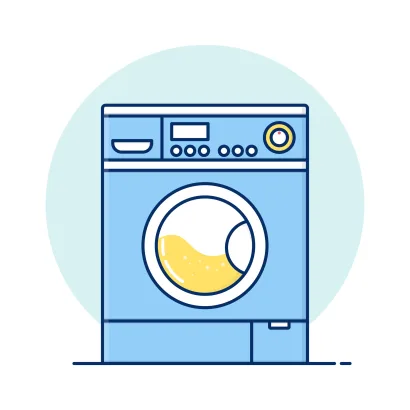Have you ever wondered what is inside your washing machine that makes it clean your clothes? Your washing machine has probably washed your clothes hundreds of times for you without you knowing how. You just put the clothes inside with a softener and cleaner, turn it on, and walk away to wait for it to finish. There are many good washing machines available in the market. You must select the best one; almost all washing machines have a similar cleansing process.
Here are some best washing machines for sale on Amazon:
No products found.
Washing Machine Cleansing Process.
Get Started
Before you attempt to wash your clothes, there are a few decisions you need to make. You can select numerous settings to ensure that your clothes are washed properly without any disasters, such as changing shape or size and having colored dyes running throughout the load. Modern washing machines are much easier to operate than old ones. You need to select the correct temperature for the clothes and the proper washing cycle for them.
For example, if you are washing woolen items, the temperature is usually displayed on the garment’s label, so you should follow the instruction that is compatible with wool. First, you should add a suitable detergent to the wash box. Now that you have the basics done, you can start the wash.
First Step
The door will automatically lock and not open until the washing cycle is complete or you press the stop button. Next, you will hear water enter the washing machine, usually from a hose feeding the cold tap on your sink. It enters via a solenoid valve at the back of the engine behind the panels. Most modern washings have only one solenoid for cold water entry, while you can plumb the older machine can for hot water and cold water. The water travels through the soapbox, picking up the detergent before entering the drum. A level switch in place will deactivate the water inlet solenoid when the required level is reached.
Second Step
The water is then heated. A heating element within the drum of the washing machine is used to heat the water. The aspect will continue to heat the water until the temperature reaches the setting you selected earlier before starting the cycle. A thermostat controls this temperature, which will turn on and off the element as required.
Third Step
When the correct temperature has been reached, the drum will start to turn in one direction. If you observe your washing machine when it is in the cycle, you notice that the drum will stop and then start turning in the opposite direction. The speed of rotation and the duration may also vary. A drive motor and belt system helps achieve the desired drum rotation. It, again, is controlled by the cycle you selected earlier.
Fourth Step
At this point in the cycle, wash the clothes sufficiently. The water now needs to be removed from the drum. There is a small extract pump located under the drum for this purpose. It will pump the water out and into a pipe which leads to a drain at the back of the washing machine.
Fifth Step
Even after removing most water from the drum, the clothes will still be very wet. This is because the washing machine will now go into a spinning cycle, rotating the drum very fast and displacing most of the remaining water. Again the pump will remove the excess water.
Last Step
At this point, the washing machine will be satisfied that the selected cycle is complete, allowing you to open the door. It would be best if you washed your clothes as you intended. If there is a problem with the washing machine, you may have to contact your local repair company.
Frequently asked questions
What happens if you select the wrong temperature or washing cycle for your clothes?
If you select the wrong temperature or washing cycle for your clothes, your clothes may be damaged or may not come out as clean as they should. Additionally, selecting the wrong temperature or cycle may cause the washing machine to use more energy and water than necessary, which can be wasteful.?
How does the drive motor and belt system control the drum rotation?
The drive motor is connected to the drum via a belt system. This belt system allows the motor to rotate the drum in either a clockwise or counterclockwise direction, depending on the direction of the motor. The speed of rotation of the drum is controlled by the motor, which can be adjusted to suit the desired speed. The belt system also prevents the drum from spinning too fast, which can cause damage to the drum and surrounding components.
What are some common problems that may occur with washing machines?
Leaking – a common problem with washing machines is leaking, usually due to a worn seal or gasket.
Loud Noises – if your washing machine is making loud noises, it could indicate an issue with the motor or the drum.
Door Won’t Open – this could be caused by a broken latch, a faulty lock, or a broken door switch.
Not Spinning – this could be due to a broken belt, worn pulleys, or a worn out motor.
Not Draining – a clogged drain hose, a faulty pump, or a worn-out pump are all common causes of this issue.?
If you like the process explanation, follow us on Facebook and Twitter.
Affiliate Disclaimer: TechEngage participates in the Amazon Services LLC Associates Program. As an Amazon Associate, we earn from qualifying purchases through links to Amazon.com and its affiliated sites. For more information, please read our disclaimer.



Share Your Thoughts